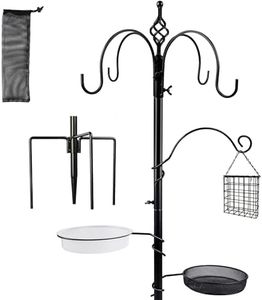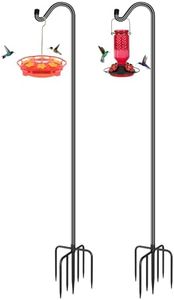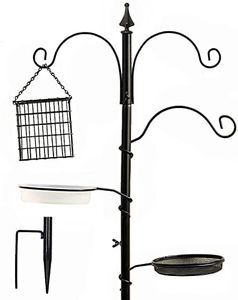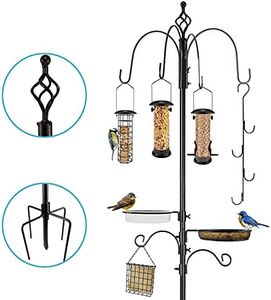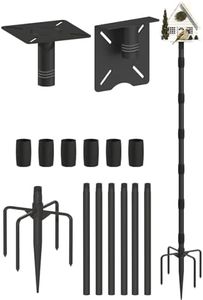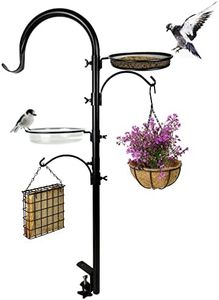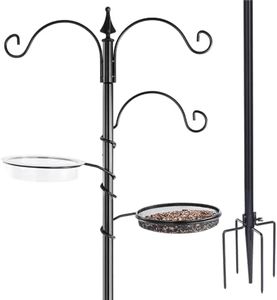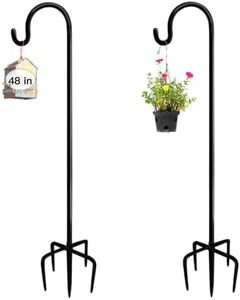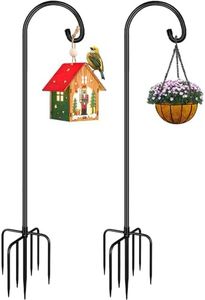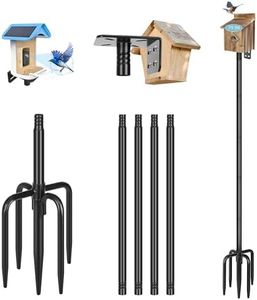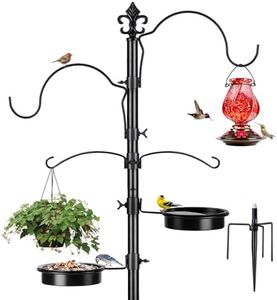We Use CookiesWe use cookies to enhance the security, performance,
functionality and for analytical and promotional activities. By continuing to browse this site you
are agreeing to our privacy policy
10 Best Bird Feeder Poles
From leading brands and best sellers available on the web.Buying Guide for the Best Bird Feeder Poles
Choosing the right bird feeder pole can make bird watching more enjoyable and help you attract the kinds of birds you want to see. When you're picking a pole, think about where you'll put it, how easy it is to maintain, and the sort of birds you hope to feed. A good bird feeder pole provides a stable, safe place for feeders and keeps animals like squirrels at bay. Taking the time to look at key features will help you find a pole that fits well with your yard and supports your feeding goals.HeightHeight refers to how tall the pole stands once it's installed in the ground. It's important because a pole that's too short may not keep feeders out of reach of squirrels, cats, or other animals, and it may not provide a good view of the birds. On the other hand, a very tall pole might make refilling feeders difficult. Shorter poles under 5 feet are easy to manage but provide less protection; mid-range poles around 5-7 feet are a good balance for visibility and animal deterrence. Taller poles are best for big yards and when you want to keep feeders well out of reach, but make sure you can still access your feeders safely. For most, a medium-height pole works best. If animals are a concern or you have large feeders, you might want to go higher.
MaterialMaterial describes what the pole is made from, such as metal, plastic, or wood. This matters because it affects how well the pole stands up to weather, heavy feeders, and animal tampering. Metal poles, especially those with weatherproof coatings, generally last longer and are sturdier. Plastic poles can be lighter and cheaper, but may crack or bend over time. Wooden poles can look attractive but often need extra protection from the elements. For most people, sturdy powder-coated metal offers the best balance of durability and ease of use.
Mounting TypeMounting type explains how you secure the pole in the ground, like with stakes, augers, or base stands. This affects how stable your pole will be and how easy it is to set up or move. Ground stakes are simple and work well in softer soil, but may be less sturdy in loose or sandy areas. Augers twist into the ground and give a stronger hold, which is better for heavy feeders or windy spots. Base stands can sit on decks or patios instead of going into the ground, making them a good choice for hard surfaces. Choose a mounting type based on your yard’s ground and whether you need to move the pole often.
Number of Hangers/ArmsThis refers to how many feeders or accessories you can hang from the pole at once. Some poles just have a single hanger, while others have several arms that can hold multiple feeders, suet cages, or bird baths. More hangers mean you can attract a wider variety of birds at once and offer different types of food, but it also means more weight and more cleaning. Think about the kinds of feeders you have (and might want in the future) and whether you need space for just one or several feeders.
Squirrel and Animal GuardsSome poles come with built-in baffles or guards, which are barriers placed on the pole to prevent squirrels or raccoons from climbing up. If these animals are a common problem in your area, having a pole with a good guard can save you frustration and keep your birdseed for the birds. There are basic baffles that work for most places, and some with more complex features for trouble spots. If you haven't had much trouble with animals before, a basic design is fine, but if you know squirrels are persistent, looking for a pole with a quality guard is a good idea.
Ease of Assembly and MaintenanceThis is about how simple it is to put the pole together and keep it clean or re-positioned. Some poles snap together with minimal effort, while others need tools and extra time. Poles that can be taken apart easily or adjusted in height are more convenient for cleaning and seasonal moving. If you prefer low-effort upkeep or expect to move your feeders with the seasons, pick a pole that's marketed as easy assembly or maintenance-friendly.
